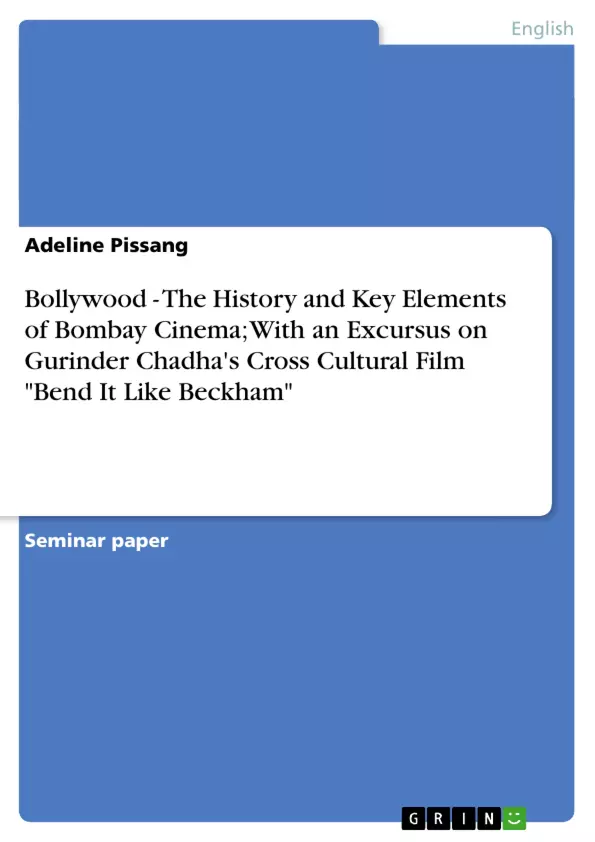“East is East, and West is West and never the twain shall meet!” (Rudyard Kipling)
It cannot be denied that the division between these opposite cultural poles
exists – but, when reflecting on the Bollywood subject, one has to disagree with this
famous quotation by Rudyard Kipling as the Indian cinematic world proves that the
East and the West can be in unison. The films of this branch are not only influenced
by their homeland’s folk tradition, they are equally affected by MTV’s video styles,
young fashion and – of course – Hollywood movies. Likewise, it is true that the
Indian spirit has recently become perceptible in Western civilization. Nowadays’
music, clothi ng and film industry – to name just a few – seem to be more and more
inspired by South Asian culture; Indian is said to be “the funkiest trend around”1
(Sardar, page 14-17).
As we shall see, both poles approach one another. Is it any surprise then
that especially non-resident Indians, living in the Western hemisphere, are the
centre where both cultures meet? Indian-English director and producer Gurinder
Chadha portrayed this mixture of Western elements and Bollywood flair
successfully in her latest movie Bend it like Beckham (2002). Among other
questions, for example those about the history of Bombay cinema, the film
industry’s costs and contents of typical Bollywood epics, this paper will also deal –
in an excursus – with this particular movie.
Some general pieces of information about this special film industry might,
first of all, provide readers with basic facts necessary for this subject. Every day, 11
million cinemagoers visit 13,000 cinemas across India and, what is more,
thousands of Indian films are watched day by day by millions of non-resident
Indians living abroad – generally, in the UK or the US. [...]
1 Examples for Bollywood slowly entering the western world can be easily displayed: Andrew Lloyd Webber
successfully produced his new musical Bombay Dreams, Monsoon Wedding was a hit in Western cinemas, the
album The very Best of Bollywood Songs recently reached the UK charts, the BBC’s advertising campaign
includes colourful trailers with female Indian dancers and Pot Noodle even created a new flavour named
Bombay Bad Boy (Sardar, page 14-17; Shamsie, page 26-29)!
Inhaltsverzeichnis (Table of Contents)
- Introductory words and various general facts about Bollywood
- Always the same film-formula – the recipe for success
- Commerce
- History of Bombay cinema
- Non-resident Indians
- The satellite and video invasion - Non-resident Indians and their favourite leisure time activity
- Indian women's traditional roles in real life and on screen
- Gurinder Chadha - An excursus on women's roles and Western and Bollywood elements in \"Bend it Like Beckham\"
- Conclusion
Zielsetzung und Themenschwerpunkte (Objectives and Key Themes)
This paper explores the history and key elements of Bollywood cinema, focusing on its impact on the West and vice versa. It specifically examines the role of non-resident Indians in bridging the gap between these two cultural poles, using Gurinder Chadha’s film “Bend It Like Beckham” as a case study. The paper also investigates the traditional roles of Indian women in both real life and on screen.
- The evolution and influence of Bollywood cinema
- The impact of Bollywood on Western culture
- The role of non-resident Indians in cultural exchange
- The representation of Indian women in Bollywood films
- Cross-cultural elements in contemporary Bollywood cinema
Zusammenfassung der Kapitel (Chapter Summaries)
- Introductory words and various general facts about Bollywood: This chapter introduces the concept of Bollywood and its significance in Indian culture. It discusses the growing influence of Indian culture in the West and the role of non-resident Indians in bridging the cultural gap. The chapter also provides basic facts about the Indian film industry, including its size and impact on the Indian economy.
- Always the same film-formula – the recipe for success: This chapter explores the typical plot structures and recurring themes in Bollywood films. It highlights the elements that contribute to the success of Bollywood movies, despite their often predictable storylines. The chapter also examines the role of commercial interests in shaping the Bollywood industry.
- History of Bombay cinema: This chapter traces the development of Bombay cinema from its early beginnings to its current status as a major global force. It explores the influences and challenges that have shaped the Indian film industry over the years. The chapter also discusses the role of key figures in the development of Bollywood.
- Non-resident Indians: This chapter focuses on the role of non-resident Indians in promoting Bollywood cinema and Indian culture in the West. It examines the impact of satellite television and video distribution on the consumption of Bollywood films abroad. The chapter also explores the cultural and social significance of Bollywood for non-resident Indians.
- Indian women's traditional roles in real life and on screen: This chapter investigates the representation of Indian women in Bollywood films. It examines the traditional roles assigned to women in Indian society and the ways in which these roles are portrayed on screen. The chapter also discusses the evolving representation of women in contemporary Bollywood films.
Schlüsselwörter (Keywords)
The key terms and concepts explored in this paper include Bollywood, Bombay cinema, Indian film industry, non-resident Indians, cultural exchange, Western culture, Indian women, traditional roles, representation, Gurinder Chadha, "Bend It Like Beckham," cross-cultural elements, and commercial success.
- Quote paper
- Adeline Pissang (Author), 2004, Bollywood - The History and Key Elements of Bombay Cinema; With an Excursus on Gurinder Chadha's Cross Cultural Film "Bend It Like Beckham", Munich, GRIN Verlag, https://www.grin.com/document/27389



